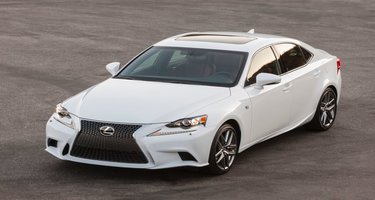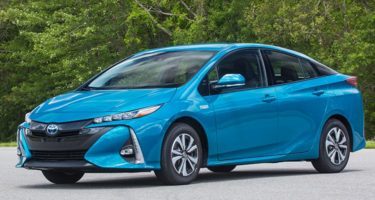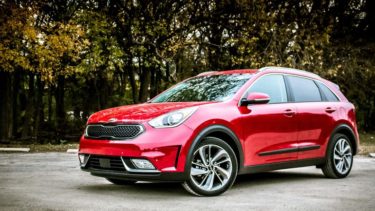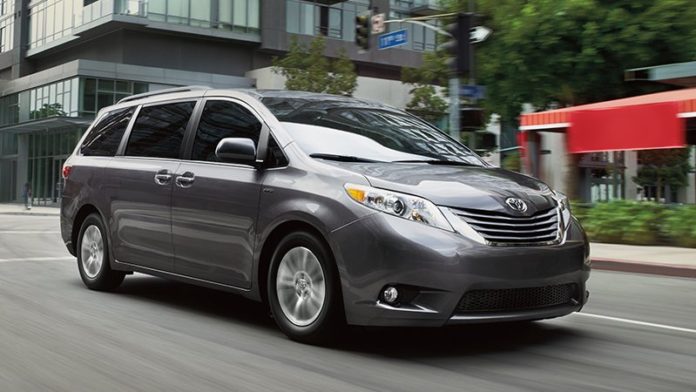As the year winds up, there are still a few vehicles worth considering—the Toyota Sienna, Lexus IS 300, Prius Prime and Kia Niro. The all-around performers have a few things in common, they are nicely packaged, easy to drive, comfortable, and have a solid build quality. Car buying season is now, so don’t wait too long to get a great deal on these 2017 models.
Toyota Sienna: Stylish, roomy, comfy and great for large families, the Toyota Sienna is a solid choice for those looking for a hauler. No box on wheels here, the Sienna has a modern streamlined exterior look, dramatic lines, sleek headlights. The minivan’s cavernous cabin is handsomely fitted; the automaker used high-grade, soft-touch materials throughout and added super supportive seating that is perfect for long road trips and soothing for bothersome lumbars. The nicely designed center console is driver-focused with all of the instruments placed within easy reach. Every Sienna trim has some version of Toyota’s Entune infotainment. The base L has a 6.1-inch touchscreen with a CD player and a four-speaker stereo. The standard system on the LE, SE, and XLE is a 7.0-inch unit with six speakers, a frustration-free navigation app, SiriusXM satellite radio, and traffic and weather updates. The Limited has the same touchscreen, plus integrated navigation and a 10-speaker JBL stereo. A pretty nice people-mover option to have is the Sienna’s in-car PA system that uses a microphone to amplify the driver’s voice to keep those rear passengers in check!
Hoarders will love the cargo room, with all seats up, you’re afforded a cargo capacity of 39.1 cubic feet, and for massive Big Box shopping, you can get up to 150 cubic feet of space with all the rear seats down. Power, precision, smooth and easy sedan-like maneuverability is how the Sienna handles on the road. The Sienna comes with a 3.5-liter V6 engine that has been upgraded for 2017 and now produces 296 horsepower and 263 lb-ft of torque. An eight-speed automatic transmission also replaces the previous six-speed. Front-wheel drive is standard on all models; the LE, XLE and Limited models offer the option of all-wheel drive. At the pumps, the front-wheel-drive Sienna’s come in at 22 mpg combined (19 city/27 highway), and the all-wheel-drive models offer 20 mpg combined (18 city/24 highway). On the safety front, in government crash tests, the 2017 Toyota Sienna received a five-star rating for overall performance, with four stars for total front-crash protection and five stars for total side-crash protection.
The 2017 Toyota Sienna gets it right all across the board, for everything from its reliability, capable handling, and smooth ride, to its well-equipped and roomy interior, versatility, and even its resale value. The seven-to-eight-passenger configuration fits well with most families’ needs, and in my opinion, it remains one of the best choices for minivan buyers. Prices start at $29,750; www.Toyota.com.

Lexus IS 300: The sporty sedan will definitely make you feel like a kid again! Zippy engine, balanced handling and posh interior, it is a well-rounded, upscale compact sedan. The IS 300 has modern-day crisp styling with aggressive exterior detailing. You’ll either love or despise the vehicle’s massive signature spindle grille, sculpted front/rear bumpers, sinister looking LED headlamps and graceful curves. Inside, the IS 300 oozes luxury with its cockpit design and explosions of leather and soft-touch surfaces everywhere. Sports seating in the IS 300 is well-bolstered and lumbar-friendly but larger frames may find them snug. There is a nice amount of head and legroom in front but don’t expect adults north of 5’3 to be comfortable in the rear because the spacing is tight. The tiered dash has futuristic appeal with everything nicely laid out for driver ease of use. The infotainment system has been criticized for not being user-friendly because of its hyperactive mouse-like controller but I did not find this to be an issue. The base cars are fitted with a laundry list of convenience features that are sure to satisfy even the most finicky car buyer. A pretty obedient 7.0-inch infotainment screen (you can upgrade to a 10.25-inch display) with clear graphics and Bluetooth connectivity are standard. All models of the Lexus IS 300 also include keyless ignition, sunroof, standard LED headlights, steering wheel-mounted audio and phone controls, Siri Eyes Free for Apple iPhones, and advanced safety systems.
Handling the quick-off-the-line, sporty sedan (the tester was fitted with a 3.5-liter V-6 with 255 hp on tap, but is mated to all-wheel drive and a 6-speed automatic) was fun from beginning to end. Solid driving dynamics, tight turning radius, well-weighted and responsive steering, the little Lexus has a very balanced suspension. As far as safety, every IS 300 now comes standard with Lexus Safety System Plus. This includes forward-collision warning and avoidance with pedestrian detection, lane-departure warning with steering assist, adaptive cruise control, and automatic high beams. According to the National Highway Traffic Safety Administration (NHTSA), the IS 300 earns a perfect 5-star overall crash-test rating.
The 2017 Lexus IS 300 can now go wheel-to-wheel with a couple of its German rivals and give them some pretty good competition too. It boasts driving excitement, precision, acceleration, and handling—folks, methinks we have a new class valedictorian! Prices start at $40,200; www.Lexus.com.

Prius Prime—The futuristic design cues on this first plug-in hybrid Prius Prime are aplenty! Aerodynamic sculpted exterior, bold lines, space age looking and dramatic two-tone grille, side body fins, dual-wave rear window with a center dip, wraparound taillights that integrate into the spoiler and penetrative Quad LED headlights. The compact has a design style that makes you look and then, look again!
As far as its innards, the Prius Prime has a sci-fi premium look with materials that appear top-shelf even though there are some hard plastics. It appears that a wee bit of cribbing went on with regards to the vehicle’s center console by way of a tablet-like color 11.6-inch touchscreen (Premium and Advanced trim models) that is reminiscent of the one found in a Tesla. If a smaller screen is preferred, the automaker offers a 7-incher that is found on the Prime Plus. Standards on the four-seater (the lithium-ion battery snatched some of its seating area space) include an integrated rearview camera and navigation, USB port, Bluetooth connectivity, Toyota Safety Sense, which bundles full-speed adaptive cruise control, pre-collision with pedestrian detection, lane-departure warning with steering assist, and automatic high beams. The seats on the sedan are long-distance-drive-comfy and have a pretty good one-size-fits-all feel. Tall drivers and passengers will find that they are nicely accommodated both head and legroom-wise, front and back.
As far as giddyap, the Prius Prime does not deliver swift acceleration off the mark but then again, it definitely was not designed to leave another car in the dust! The car’s ride is quiet, very smooth and with handling that is reflexive. The brakes deliver strong, smooth stopping power. The Prime has a 1.8-liter 4-cylinder engine that kicks out 95 horses, combined with two electric motors that put out 76kW, the result, 121 horses. The 8.8 kWh battery allows you to drive on just electricity for about 25 miles at speeds of up to 84 mph. In hybrid mode, it beats the regular Prius by a few mpg. Recharging times for the Prime are about two hours using a 240V charger, or a little more than five hours on a standard 120V outlet. The Prius does not need to be plugged in and can just run on gasoline. The EPA city/highway fuel economy is 55/53 mpg, 133 MPGe (EV mode).
The Insurance Institute for Highway Safety, ‘Top Safety Pick+’ sports an overall design that rings its exterior and interior. The Prius Prime also offers respectable handling and quite a bit of fuel savings to boot which should especially catch the attention of daily commuters. Prices start at $27,100; www.toyota.com.

Kia Niro–The 2017 Kia Niro has an exterior that quite a few find appealing and others have criticized as having a look that only a mother can love. Those who think that the compact hybrid crossover’s styling cues make it unattractive can go kick rocks! The Niro has visual splash with its unhybrid look and resemblance to its sister, the Sorrento.
Inside, the hybrid sports a really modern looking, roomy, well-packaged interior for carrying folks and stuff. The Niro also gets extra points for its ease of its ingress, egress and seat heights that are a godsend for seniors. It has wonderful forward visibility and a rearview camera that is standard across its five trims. The front and rear boast plentiful head and legroom for a wide range of passengers. The seating in the compact is sofa-comfy with noteworthy lumbar and lateral support. Sensible functionality seems to be a priority for the automaker because its 7-inch touchscreen (base) and controls are straightforward and offer frustration-free operation. Bluetooth pairing and the optional navigation are noteworthy mentions because they are such a breeze to get going. Kia’s UVO infotainment system boasts Android Auto and Apple CarPlay connectivity. As far as cargo room, the Niro has a healthy amount of it, with the rear seats up, it offers 19.4 cubic feet of space, and 54.5 with them down.
Kia kicks it up on the safety front the higher in trims you go. The LX comes equipped with blind-spot monitoring with lane change assist and rear cross-traffic alerts. The next model up, the EX, gets an optional package that adds forward collision warning, lane-keeping steering assist, automatic emergency braking with pedestrian detection and adaptive cruise control. Finally, the top-tier Touring models gain standard front and rear proximity detection at parking speeds. All in all, the list of available features is well-sorted.
And speaking of pumps, the Niro manages to achieve fuel economy ratings of 52 mpg in the city, 49 on the highway, and 50 combined for the base FE model. Moving up to the slightly better-equipped LX and EX-models yield a small decrease to 51 city, 46 highway, and 49 overall. If you opt for the Touring model, it offers 46 city, 40 highway, and 43 overall.
The compact hybrid crossover SUV has spunk and is totally car-like when it comes to handling. It inspires confidence the minute you get behind the wheel and give it some gas (EX, test vehicle). Don’t let the 1.6-liter 4-cylinder and 43-hp electric motor with its 146 horses and 195 lb-ft of torque fool you for one bit. Off the mark, the Niro gets going without a bit of hesitation; the acceleration is really responsive with steering that is direct. It is peppy, easy to maneuver, stays planted during sharp cornering and offers a ride that is truly fun, solid and quiet to boot.
Kia kicks it up on the safety front the higher in trims you go. The LX comes equipped with blind-spot monitoring with lane change assist and rear cross-traffic alerts. The next model up, the EX, gets an optional package that adds forward collision warning, lane-keeping steering assist, automatic emergency braking with pedestrian detection and adaptive cruise control. Finally, the top-tier Touring models gain standard front and rear proximity detection at parking speeds. All in all, the list of available features is pretty well-sorted.
The 2017 Kia Niro is a compact crossover with everything a buyer could want in a vehicle and then some. Competent, solid, comfy, easy on the eyes and the cherry on the top is its great fuel economy. The Niro is worth a serious consideration when looking for a compact that delivers across the board. Prices start at $22,890; www.Kia.com











